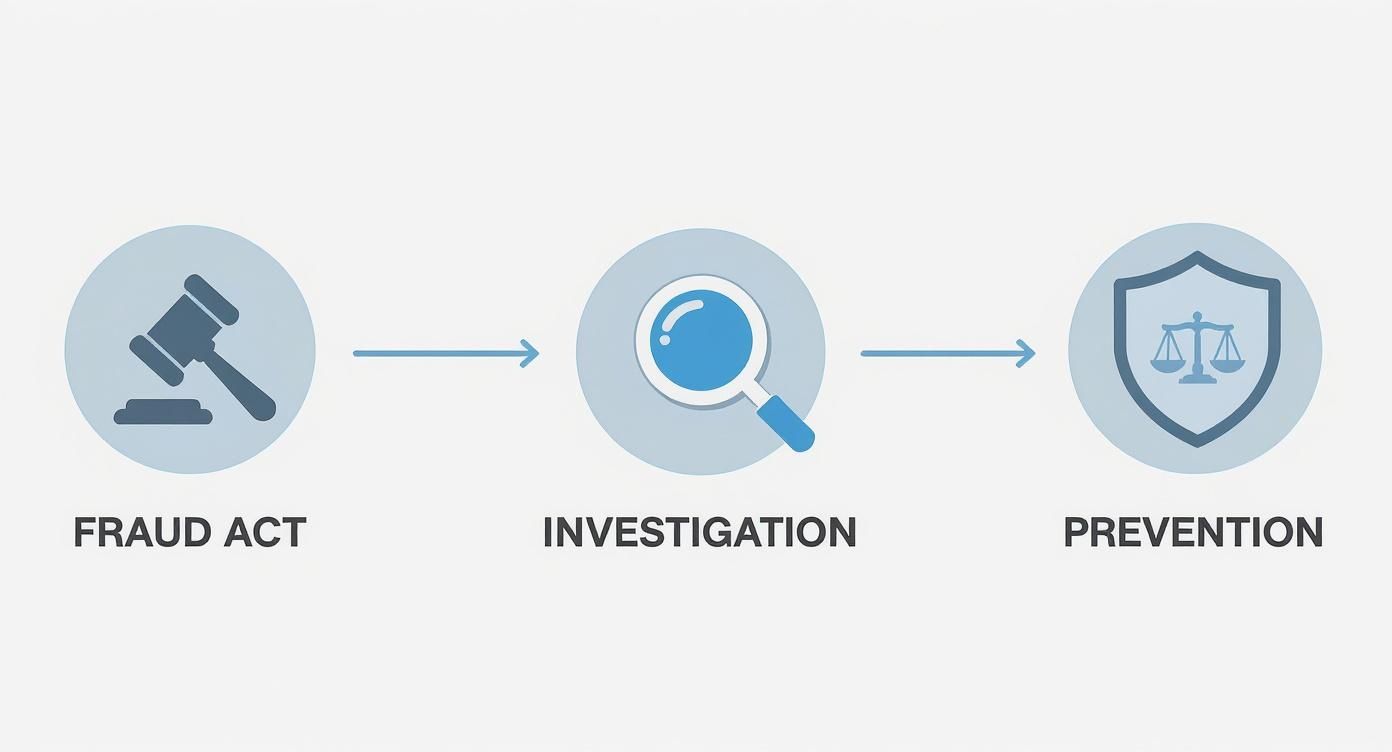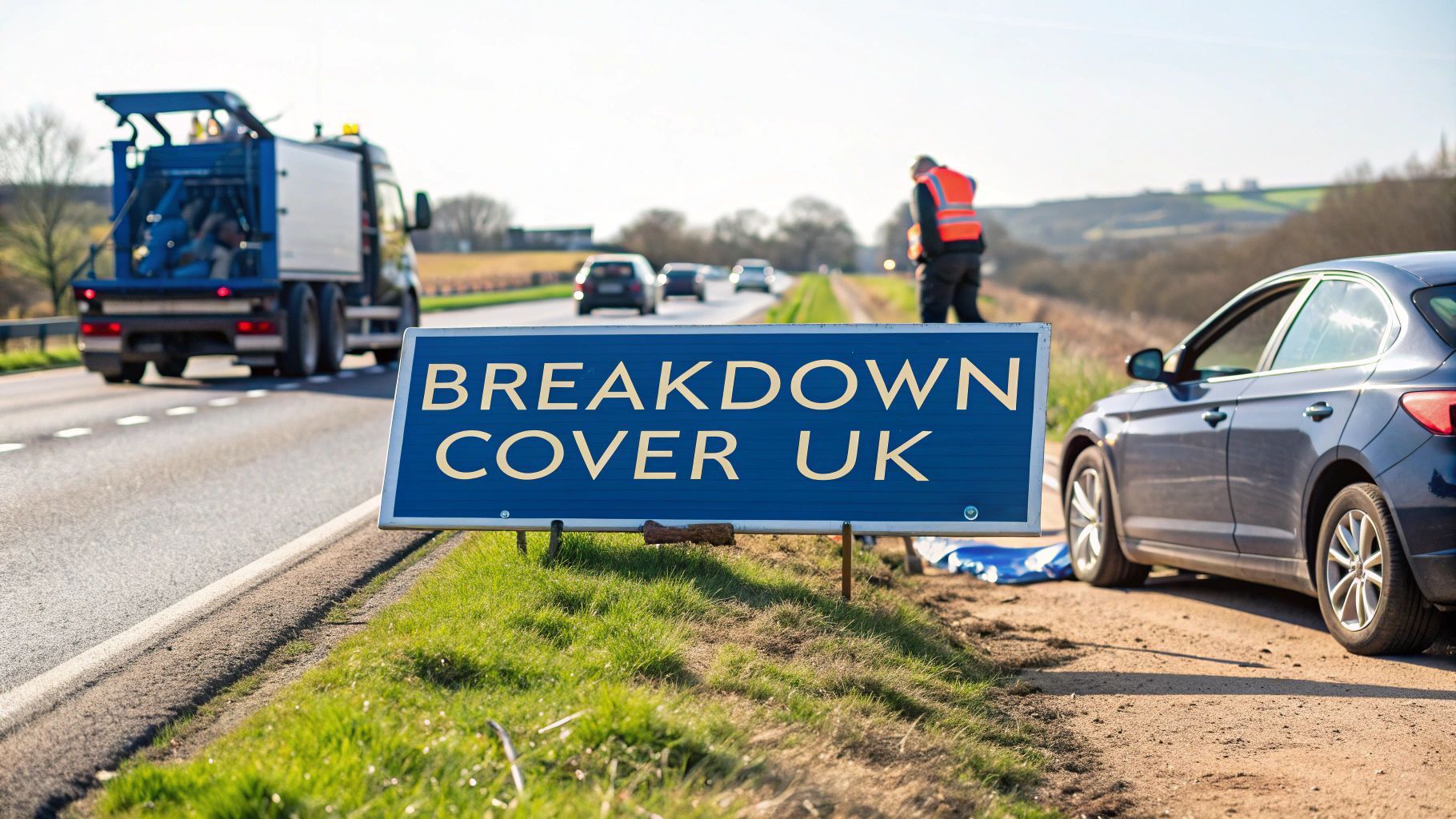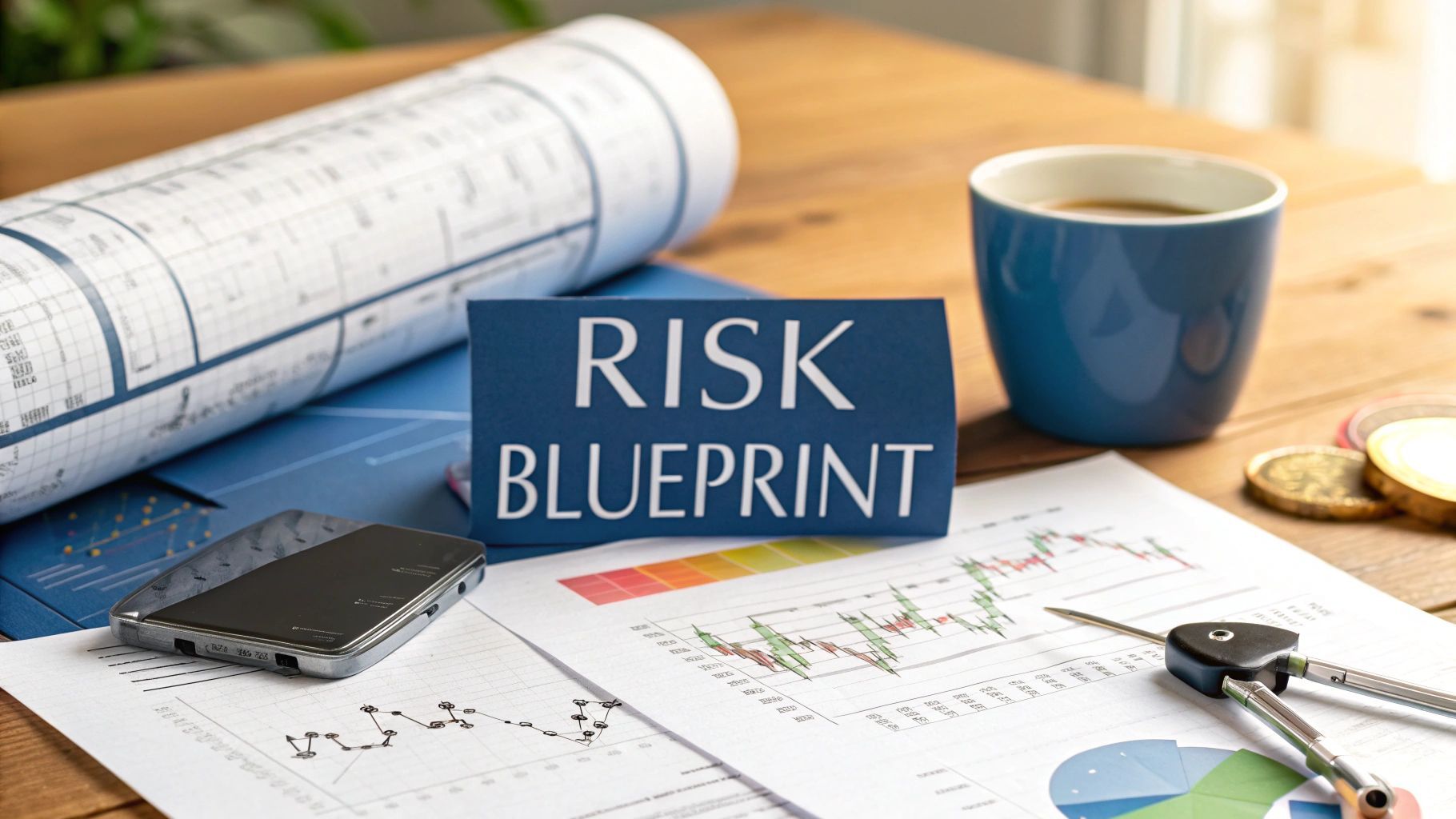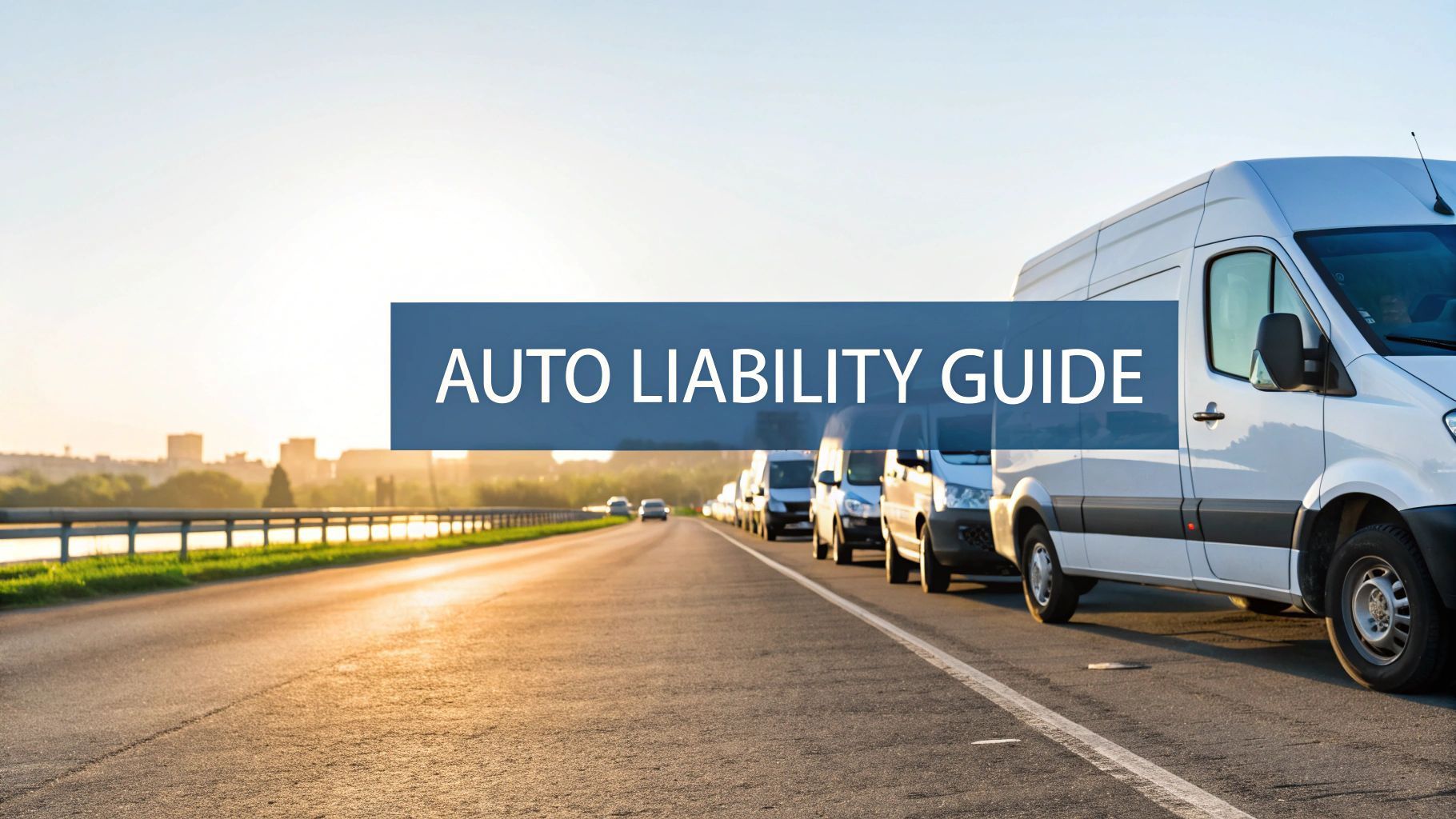UK Insurance Fraud Prevention Authority Explained
In the UK there is not one single organisation that handles the fight against insurance fraud. Instead what we have is a coordinated network of different bodies all working together with a shared mission: to detect, disrupt and prevent fraudulent activity. Their work is crucial for safeguarding the industry and protecting honest policyholders from the fallout.
The Collective Defence Against Insurance Fraud

Insurance fraud is a stubborn and expensive problem that one way or another affects everyone. It runs the gamut from someone opportunistically exaggerating a claim all the way to highly organised criminal rings staging accidents for profit. This forces insurers to pay out on illegitimate claims leading to huge financial losses.
But those costs do not just disappear into an insurer's balance sheet. They get passed directly on to every single policyholder in the form of higher annual premiums. It means honest customers end up footing the bill for the actions of a dishonest few. You can get a clearer picture of the staggering financial impact in our article on what insurance fraud really costs the industry.
The Challenge of Provability
One of the biggest hurdles in tackling fraud is provability . Accusing someone of fraud is a serious allegation and it demands solid, verifiable evidence. An insurer cannot just act on a suspicion; they have to be able to prove it. The burden of proof is high as it requires evidence that shows dishonest intent beyond all reasonable doubt.
This is exactly where the UK's network of fraud prevention bodies becomes so vital. They provide the framework for insurers to share data, flag suspicious activity and build robust cases that can stand up in court.
By creating a united front these authorities make it much harder for fraudsters to slip through the cracks. Their collective work involves:
- Data Sharing: Pooling information from multiple insurers to spot suspicious patterns and identify repeat offenders.
- Investigation: Offering specialist resources to dig into complex and organised fraud cases.
- Enforcement: Collaborating with law enforcement to bring fraudsters to justice.
- Public Awareness: Educating consumers on the real-world consequences of fraud and how to spot common scams.
Shifting Attitudes and Persistent Threats
Despite these coordinated efforts a worrying number of people still see insurance fraud as a victimless crime. The Insurance Fraud Bureau (IFB), a key player in this collective effort, has highlighted this exact issue.
According to a recent YouGov survey they commissioned, more than one in ten adults (11%) believe it is acceptable to lie on a claim to make money. Even more concerning, 17% think it is fine to lie on an application just to save a bit of cash.
This gap in perception really drives home why a dedicated insurance fraud prevention authority is so important. It is not just about catching criminals; it is about reinforcing the fundamental principle that insurance is built on honesty and that fraudulent actions have real financial consequences for everyone.
By working together these organisations uphold the integrity of the entire insurance system. They protect businesses from financial loss and crucially help keep premiums affordable for the vast majority of honest policyholders who depend on insurance for their peace of mind.
Meet the Key Players Tackling Insurance Fraud
To get your head around how the UK fights insurance fraud you need to know the specialist organisations on the front line. Think of them as a coordinated team each with a distinct but complementary role. One gathers intelligence, another investigates and enforces the law and a third sets the ground rules for the entire game.
This collaborative structure is the backbone of the UK’s defence. While each body has its own specific mission their combined efforts create a seriously formidable barrier against everything from minor claims exaggeration to large-scale organised crime. Let’s meet the players.
The Insurance Fraud Bureau (IFB) The Intelligence Hub
The Insurance Fraud Bureau (IFB) is the central nervous system for the industry’s counter-fraud efforts. Its main job is to collect and analyse enormous amounts of data from insurers all over the country spotting suspicious patterns and connections that would be impossible for any single company to see.
Picture this: one insurer flags a questionable claim. On its own it might just look like a one-off. But the IFB can see the bigger picture. It connects that claim to similar ones made with different companies and suddenly what looked like a small issue is revealed as a coordinated ‘crash for cash’ ring or a serial fraudster at work.
The IFB also manages critical resources like the Insurance Fraud Register (IFR) , a database of known fraudsters. This shared intelligence is absolutely vital helping insurers make smarter decisions and stop losses before they even happen. Ultimately this protects honest customers from paying for the fraudsters' crimes through higher premiums.
The Insurance Fraud Enforcement Department (IFED) The Specialist Police Unit
When the IFB’s data analysis points to serious, organised or particularly complex fraud the case is often handed over to the Insurance Fraud Enforcement Department (IFED). This is a specialist police unit funded by the insurance industry but operating independently within the City of London Police.
IFED’s role is simple: conduct criminal investigations. They are the boots on the ground with the legal authority to arrest suspects, execute search warrants and build the rock-solid cases needed for prosecution. Their focus is on bringing criminals to justice sending a very clear message that insurance fraud is a high-risk crime with serious consequences.
By providing a dedicated law enforcement response IFED ensures the most serious offenders are held accountable. This creates a powerful deterrent and dismantles criminal networks that would otherwise cost the industry—and its customers—millions of pounds each year.
The Financial Conduct Authority (FCA) The Rule Setter
The Financial Conduct Authority (FCA) plays a broader but equally vital role. As the UK's top financial services regulator its mission is to make sure markets work properly and consumers get a fair deal. While not a fraud unit per se its regulations are fundamental to creating an environment where fraud struggles to take root.
The FCA is the one that sets the rules insurers must follow from the fair treatment of customers to the need for robust internal controls. Crucially they mandate that all firms must have effective systems in place to prevent financial crime a requirement that directly strengthens the fight against insurance fraud.
Their work ensures the entire industry operates with integrity. This not only builds consumer trust but also establishes a high standard of conduct that discourages dishonest behaviour from the get-go.
This table breaks down how these key UK authorities work together each playing a crucial part in the wider strategy to prevent insurance fraud.
Key UK Authorities and Their Core Functions in Fraud Prevention
| Authority/Organisation | Primary Role | Key Responsibilities |
|---|---|---|
| Insurance Fraud Bureau (IFB) | Central Intelligence Hub | Manages cross-industry data sharing, identifies fraud networks and maintains the Insurance Fraud Register (IFR). |
| Insurance Fraud Enforcement Department (IFED) | Specialist Police Unit | Investigates complex and serious insurance fraud, makes arrests and builds cases for criminal prosecution. |
| Financial Conduct Authority (FCA) | Industry Regulator | Sets rules for fair practice, mandates anti-financial crime systems and supervises firms to ensure compliance. |
When you put them all together these three organisations form a powerful alliance. The IFB spots the patterns, IFED pursues the criminals and the FCA makes sure the industry’s defences are strong. This multi-layered approach is the cornerstone of the UK’s strategy to make insurance safer and fairer for everyone.
The Legal Framework That Powers Fraud Prevention
An insurance fraud prevention authority does not just operate on good faith. Its real power—the ability to investigate, disrupt and penalise fraudsters—is built on a solid legal framework. These laws are what give the fight against fraud its teeth turning what might otherwise be a simple breach of policy terms into a serious criminal offence with life-changing consequences.
Without this legal backing any effort to tackle fraud would be little more than an internal company policy. It is this structure that allows organisations like IFED to launch full-blown criminal investigations and bring fraudsters to justice. It draws a clear, sharp line between an honest mistake on a claim form and a deliberate, calculated attempt to deceive for financial gain. For insurers and their honest customers this framework is the ultimate line of defence.
The Cornerstone Law: The Fraud Act 2006
The central pillar supporting the UK's fight against insurance fraud is the Fraud Act 2006 . Before this Act came into force prosecutors had to pick their way through a complicated mess of different deception offences many of which were notoriously difficult to prove in court. The 2006 Act swept all that away creating a single, broad offence of fraud.
This was a complete game-changer. It clearly defined three main ways someone can commit fraud all of which are directly relevant to the world of insurance:
- Fraud by false representation: This is the one we see most often. It covers everything from lying about your claims history to get a cheaper premium right through to inventing a stolen laptop on a home insurance claim.
- Fraud by failing to disclose information: This kicks in when someone has a legal duty to share information but deliberately keeps quiet. A classic example is not telling your car insurer about a performance-enhancing modification that would have pushed your premium up.
- Fraud by abuse of position: While less common for everyday policyholders this is crucial for tackling insider fraud where someone within an insurance company abuses their trusted role to commit or enable fraud.
By defining fraud so clearly the Act handed investigators a direct and powerful tool. It smartly shifts the focus onto the defendant's dishonest intent rather than getting bogged down in proving the victim was deceived making it much easier to build a case and secure a conviction.
Shifting Responsibility: A Proactive Approach
More recently the legal landscape has started to evolve. There has been a significant shift away from simply reacting to fraud after it has happened towards placing a much greater responsibility on organisations to prevent economic crime in the first place.
A key part of this is the introduction of new corporate offences. The UK government and regulators have brought in legislative measures like the 'Failure to Prevent Fraud' (FTPF) offence which has massively expanded corporate liability. It means thousands of UK companies including all the major insurers now have to implement genuinely robust anti-fraud controls.
Under these rules a large organisation can be held criminally liable if an employee commits fraud for the company’s benefit and the business cannot prove it had reasonable prevention procedures in place. You can explore further insights into insurer best practices on this topic.
This legislative shift is crucial. It forces businesses to move beyond a reactive, "catch them if you can" mindset and instead build a culture of fraud prevention from the ground up. It makes them an active partner in the nationwide effort to clamp down on economic crime.
The Consequences of Committing Fraud
The legal framework does not just define the crime; it spells out the punishment. Getting convicted of fraud under the 2006 Act is no slap on the wrist. The consequences are serious, serve as a powerful deterrent and can follow you for the rest of your life.
An individual found guilty of insurance fraud could be looking at:
- A criminal record: This can slam the door on future job opportunities, make it difficult to travel and create massive hurdles when applying for a mortgage or loan.
- A custodial sentence: The most serious cases, especially those involving organised fraud rings, can lead to significant prison time.
- Financial penalties: On top of hefty fines, courts can order the repayment of every penny obtained through the fraud.
- Difficulty obtaining future insurance: A fraud conviction is a one-way ticket to being blacklisted. Getting cover in the future becomes incredibly difficult and eye-wateringly expensive.
This robust legal backing is what ensures the work of any insurance fraud prevention authority has real weight. It sends a clear message: insurance fraud is not a victimless or trivial matter. It is a criminal act with severe repercussions for anyone foolish enough to try it.
How Authorities Investigate and Disrupt Fraud
An insurance fraud prevention authority needs more than just tough laws to make a real difference. It requires sharp, effective tactics to turn a vague suspicion into solid proof. This is where the real work of investigation and disruption kicks in transforming raw data into actionable intelligence and building cases that can take down fraudulent operations, one piece at a time.
This whole process relies heavily on collaboration. Insurers cannot win this fight on their own and authorities are powerless without the right information from the industry. It is this steady flow of data between insurers and their fraud-fighting partners that truly turns the tide against criminals protecting both businesses and honest customers from the fallout.
The Power of Shared Intelligence
Nearly every major investigation starts with one thing: data. Authorities like the Insurance Fraud Bureau (IFB) serve as a central hub collecting and analysing claim information from across the entire industry. By itself a single suspicious claim might not raise many alarms. But when you pool it with thousands of others clear patterns start to jump out.
This shared intelligence is the bedrock of modern fraud detection. It allows investigators to connect dots that would otherwise stay hidden—like spotting the same individuals popping up in multiple claims or noticing similar accident details being reported over and over in specific postcodes.
A perfect example of this is the Insurance Fraud Register (IFR) , which is managed by the IFB. Think of it as a shared database of individuals with a proven track record of making fraudulent claims. Before an insurer pays out they can run a quick check against the IFR instantly flagging high-risk individuals and stopping a fraudulent payment before a single penny is lost.
From Red Flag to Concrete Evidence
Once data analysis throws up a potential red flag the real investigative journey begins. This is not a quick job; it is a meticulous process of gathering enough evidence to prove dishonest intent beyond any reasonable doubt.
The typical path from suspicion to proof involves a few key stages:
- Initial Triage: An analyst first reviews the alert. Is there a link to a known fraudster on the IFR? Does the claim look suspiciously similar to a known scam?
- Evidence Gathering: Next, investigators start digging. This could involve anything from examining documents for tell-tale signs of forgery, analysing digital photos for manipulation or even conducting interviews with witnesses.
- Surveillance and Fieldwork: For the more complex cases, especially those involving organised crime rings behind 'crash for cash' schemes, specialist units like IFED might carry out surveillance to watch suspects and gather undeniable proof of their fraudulent activities.
- Case Building: Finally, all the evidence is pulled together into a watertight file ready to be passed on for prosecution. The aim is to build a case so strong that there is simply no room for doubt.
This infographic neatly shows the flow from the legal foundation right through to investigation and prevention.

As you can see the legal authority is what underpins every single investigative action leading directly to protective measures that benefit the entire industry.
Proactive Disruption and Public Awareness
Catching fraudsters after the fact is only half the battle. A truly effective insurance fraud prevention authority also works to disrupt their activities before they can even get started. This proactive mindset is essential for cutting down the sheer volume of fraudulent claims being made.
Disruption can be direct, like working with police to dismantle organised crime rings before they can stage more fake accidents. But honestly one of the most powerful tools in the arsenal is public education.
By raising awareness of common scams authorities empower the public to become the first line of defence. When people know what to look for they are far less likely to become either victims or unwitting participants in a fraudulent scheme.
Campaigns that shine a light on the dangers of 'crash for cash' schemes or ghost broking help everyday people spot the warning signs. This does not just stop individual scams; it makes it much harder for fraudsters to operate at all. The UK’s insurance sector has seen a sharp rise in detected fraud which shows both the scale of the problem and the success of these improved detection methods. For example in the first half of one recent year a single major insurer detected frauds worth £93 million —a 34% increase from the previous year. This has pushed bodies like the IFB to expand their data-sharing work even further. You can read more about the government's response to public sector fraud in their latest annual report.
The Impact of Technology in Modern Fraud Detection

The fight against insurance fraud has well and truly moved into the digital arena. Where investigators once relied on paperwork and a sharp instinct today’s counter-fraud efforts are powered by some seriously clever tech. This shift is completely changing how an insurance fraud prevention authority and individual insurers can defend against increasingly complex criminal tactics.
This is not just about doing the old things faster; it is about changing the very nature of detection. It allows us to be more proactive, predictive and evidence-based stopping fraud in its tracks before it costs the industry—and by extension honest policyholders—millions of pounds.
The Rise of AI and Machine Learning
At the heart of this change you will find Artificial Intelligence (AI) and Machine Learning (ML). These systems are exceptionally good at a task that humans find almost impossible: sifting through immense datasets to spot subtle red flags and hidden connections. An AI can analyse thousands of claims a minute flagging suspicious patterns that would otherwise fly straight under the radar.
Think of it this way: an ML algorithm can learn what a "normal" claim looks like for a specific type of policy. When a new claim comes in that deviates from this baseline—perhaps the story is just a bit too similar to another recent claim or it includes details linked to known fraudulent schemes—it is automatically flagged for a human expert to review.
This automation frees up experienced investigators to focus their skills on the most complex and high-value cases. Instead of drowning in a sea of paperwork they can direct their attention where it is needed most acting on high-quality, data-driven leads. In an industry dealing with a massive volume of claims every day that efficiency is critical.
Bolstering the Provability of Claims
One of the biggest headaches in fraud prevention has always been proving that a claim is legitimate (or not). Technology gives us powerful new ways to gather the verifiable evidence needed to confidently confirm or deny a claim putting insurers on much firmer ground.
Digital evidence creates a clearer, more objective picture of a claim. It moves the conversation from "he said, she said" to a fact-based analysis making it much harder for fraudsters to succeed with fabricated stories.
This is achieved by cross-referencing a whole range of digital footprints. Investigators can now analyse:
- Geolocation Data: Checking if a claimant's device location actually matches the reported incident location.
- Digital Timestamps: Verifying when photos or documents were created to prevent "after the event" fraud where someone insures an item after it has already been damaged or stolen.
- Social Media Activity: Uncovering public posts that contradict the details of a claim, like someone claiming a debilitating injury while posting photos of a skiing holiday.
As fraudsters get savvier with manipulated images knowing how to check if a photo is real has become an essential skill for investigators navigating this new digital landscape.
Creating a Robust Internal Defence
This ecosystem of technologies also allows insurers to build a more resilient internal defence against fraud from day one. By weaving these tools into their core processes they create a stronger, more secure claims-handling environment right from the start. We are now seeing platforms emerge that are specifically designed to tackle these verification challenges head-on.
Solutions now exist that let policyholders create a verified digital inventory of their possessions at the very beginning of a policy. For an insurer this is a game-changer. It provides a clear, timestamped record of what is being insured and its condition making it exceptionally difficult for a claimant to exaggerate their losses down the line.
This approach does not just help in fighting fraud; it builds trust and transparency. By fighting fraud before it happens with the power of verified evidence , insurers can process legitimate claims faster improving the experience for their honest customers while making life much, much harder for fraudsters.
How Insurers Can Effectively Work with Authorities
Engaging with an insurance fraud prevention authority is not just a box-ticking exercise for insurers. It is a proactive strategy that strengthens the entire industry’s defences, protects honest customers and ultimately defends your bottom line.
Think of it as a two-way street. Authorities rely on high-quality, timely information from insurers to spot criminal networks while insurers benefit from the resulting intelligence and enforcement actions. Building a strong working relationship is the only way to get ahead of fraudsters.
Mastering Data Sharing Protocols
The foundation of any real collaboration is built on solid data sharing. Insurers need to be active participants in schemes like those managed by the Insurance Fraud Bureau (IFB). This means more than just occasionally submitting data; it means doing it correctly, securely and consistently.
Here are a few best practices to keep in mind:
- Accuracy: Clean, accurate data is everything. Submitting messy information can generate false positives and muddy the intelligence pool for everyone.
- Timeliness: Report suspicious claims as soon as you spot them. Delays give fraudsters the window they need to disappear or try their luck with another insurer.
- Security: Always stick to data protection and security protocols. It is non-negotiable for staying compliant and protecting sensitive customer information.
This collaborative spirit extends to other players in the insurance world. For example understanding the role of an acceptance agency insurance and notary can shine a light on how different bodies work together to secure transactions.
Making Effective Referrals
When your team uncovers a case with strong evidence of serious or organised fraud knowing how to make an effective referral to a body like the Insurance Fraud Enforcement Department (IFED) is crucial. A well-prepared referral package is far more likely to be investigated and lead to a prosecution.
A referral should be a comprehensive, evidence-based package, not just a data dump. Presenting a clear, well-documented case gives investigators the best possible starting point and significantly increases the chance of a successful outcome.
To make an impact focus on telling a clear story supported by all the evidence you have. This includes detailed claim notes, records of suspicious conversations and any proof of misrepresentation. Your goal is to show deliberate, provable deception. This teamwork is a vital part of tackling what has become a global fraud epidemic and Proova is fighting back with solutions that verify information right from the start.
Building an Internal Culture of Vigilance
The best external collaborations begin with a strong internal culture. Your staff—from underwriters to claims handlers—are your first line of defence. Continuous, practical training is essential to give them the skills to spot red flags early.
Training should cover common fraud indicators, new scam tactics and clear internal steps for escalating suspicious activity. When employees feel empowered and know exactly what to do the quality of intelligence you can share with authorities skyrockets. This internal vigilance acts as a powerful filter making sure only the most credible and well-supported cases get passed on for action.
Got Questions About Insurance Fraud Prevention?
Diving into the world of insurance fraud prevention can bring up a lot of questions whether you are a business owner or just a regular policyholder. Getting a handle on how these fraud prevention authorities work is key to seeing the bigger picture – the collective effort to keep insurance fair and affordable for everyone.
Let's break down some of the most common queries. These answers should help clear up the confusion revealing the real cost of fraud and the part we all play in keeping the system honest.
Why Does Insurance Fraud Cost Everyone Money?
Insurance fraud is anything but a victimless crime. When an insurer pays out for a fake or padded claim that money has to come from somewhere. To cover those losses the industry has to increase premiums across the board. The result? Honest customers end up footing the bill for the actions of a dishonest few.
Think of it like this: every fraudulent claim is a hidden tax on your insurance policy. This is exactly why the work of any insurance fraud prevention authority is so important. Their efforts to stop this financial drain directly help keep your premiums from climbing.
What's the Difference Between Soft and Hard Fraud?
This is a really important distinction. Soft fraud , which is sometimes called opportunistic fraud, is by far the more common of the two. It happens when someone with a legitimate claim decides to exaggerate it – for example adding a pricey laptop they never owned to a list of stolen items after a real burglary. It is often seen as a small fib but it adds up to millions.
Hard fraud is a different beast altogether. This is where someone deliberately stages an incident, like faking a car crash or intentionally setting a fire, with the sole purpose of making a claim. These cases are often meticulously planned, sometimes by organised criminal gangs, and they are a major focus for fraud investigators.
What Are the Consequences of Getting Caught?
The fallout from being caught is much bigger than just having a claim denied. A conviction for insurance fraud leaves you with a criminal record which can throw a spanner in the works for future job prospects, international travel and even your ability to get a loan or mortgage.
Beyond the legal penalties anyone caught committing fraud is usually added to the Insurance Fraud Register (IFR). This makes it incredibly difficult and eye-wateringly expensive to get any kind of insurance in the future from car and home cover right through to life insurance.
How Can I Report Suspected Insurance Fraud?
If you think someone is committing insurance fraud you can report it completely anonymously. The Insurance Fraud Bureau (IFB) operates a confidential Cheatline where you can pass on what you know without giving your name.
Every report, no matter how small it seems, provides valuable intelligence. It helps the authorities connect the dots, build a bigger picture and disrupt fraudulent operations protecting the whole community from the financial hit.
At Proova , we believe proving the truth should be simple. Our platform provides a secure way to verify assets before a claim is even made, creating a clear, indisputable record that protects both insurers and honest customers. By establishing provability from day one, we help stop fraud before it starts. See how we are making insurance fairer at https://www.proova.com.












